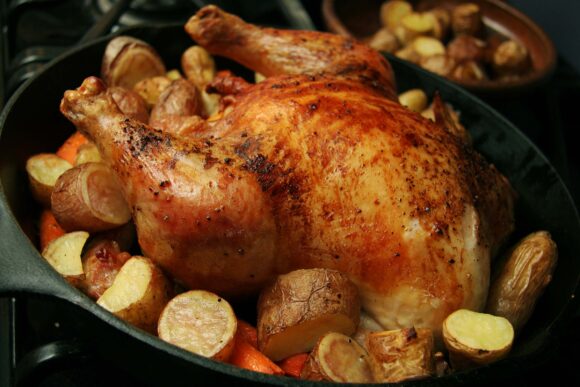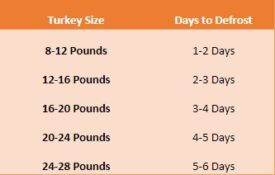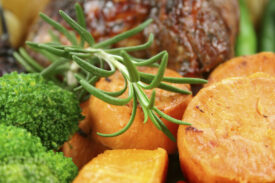 By Luanne J. Hughes, MS, RDN: Educator & Professor, Rutgers Cooperative Extension of Gloucester County
By Luanne J. Hughes, MS, RDN: Educator & Professor, Rutgers Cooperative Extension of Gloucester County
Thanksgiving is just a few days away. One of our biggest food holidays of the year, Thanksgiving brings with it great anticipation about family, food, and fun. But it can also arouse a bit of apprehension over the monumental task of food preparation and keeping food safe so guests can enjoy their meals without concern for foodborne illness. Managing the Thanksgiving feast — whether it’s preparing the turkey and the sides, coordinating the shopping, or managing leftovers – can be daunting.
For those concerned about preparing this special meal, don’t worry, FCHS and the USDA are here to help. The FCHS fact sheet, Turkey Talk, will walk you through every step of Thanksgiving meal preparation and food safety. And the USDA Meat and Poultry Hotline is available all week – including on Thanksgiving Day – to answer your questions. Call 1-888-674-6854 between 10:00am and 6:00 pm.
As you prepare for Thanksgiving, FCHS department members share some of their best strategies to keep your feast safe. Here are a few quick tips to get you started:
Rachel Tansey, FCHS program associate in Monmouth County says, “You can’t go wrong if you’re mindful of the basic food safety principles we should practice every day.” Tansey says that these standard food safety principles are key to keeping your food safe and reducing risk of foodborne illness on Thanksgiving and every day:
Clean: Keep bacteria out of your kitchen by washing your hands before, during and after you handle raw food. Make sure food preparation surfaces and utensils are clean.
Separate: Keep raw meat and poultry separate from produce and cooked foods by using different cutting boards.
Cook: Use a food thermometer to ensure your turkey is safe to eat. The recommended internal temperature must reach 165oF in three places: the thickest part of the breast, the innermost part of the thigh and the innermost part of the wing.
Chill: Your meal on the dinner table has only two hours before it becomes unsafe, and bacteria start to multiply. Make sure you put out just enough food for your guests and place the rest in your fridge in shallow containers.
Thawing Safely
FCHS professor Karen Ensle, with Rutgers Cooperative Extension of Union County, reminds us that thawing a frozen turkey properly can significantly reduce foodborne illness risk. There are three safe ways to thaw your turkey:
 Refrigerator: “Place turkey in your refrigerator to thaw, NOT on the counter.” Ensle says it is best to plan ahead for slow, safe thawing in the refrigerator. Ensle adds that thawing in the refrigerator is the preferred way to defrost. Your turkey will require at least a day (24 hours) for every 5 pounds of turkey weight.
Refrigerator: “Place turkey in your refrigerator to thaw, NOT on the counter.” Ensle says it is best to plan ahead for slow, safe thawing in the refrigerator. Ensle adds that thawing in the refrigerator is the preferred way to defrost. Your turkey will require at least a day (24 hours) for every 5 pounds of turkey weight. - Cold Water: This method is faster than refrigerator thawing but requires more attention. The turkey should be in leak-proof packaging or a plastic bag. Submerge the turkey in cold tap water, changing the water every 30 minutes. It will take about 30 minutes per pound. After thawing, refrigerate the turkey and cook it promptly.
- Microwave: All microwaves are different. Check the manufacturer’s instructions for the size turkey that will fit into your oven, the minutes per pound, and the power level to use for thawing. After microwave thawing, cook the turkey immediately, because some areas of the turkey may become warm and begin to cook.
Is It Done Yet?
After thawing, FCHS educators throughout the state report that judging turkey “doneness” is the next most-asked question for Thanksgiving. FCHS educator and registered dietitian nutritionist Sandra Grenci from Hunterdon County reminds consumers, “Don’t judge the doneness of the turkey by the color of the meat or time in the oven. Use a food thermometer to cook to recommended temperature of 165°F.” Insert an oven-safe meat thermometer into the thickest part of the thigh. Place turkey in a preheated 325○F oven. Avoid recipes that recommend slow cooking at temperatures below 325○F. Lower temperatures won’t kill bacteria.
Planning to stuff your bird? Grenci recommends following these tips to keep your stuffing safe and delicious:
- Prepare stuffing just before placing it in the turkey. Use only cooked ingredients in stuffing – sautéed vegetables, cooked meats, and seafood (such as sausage or oysters) and use pasteurized products instead of raw eggs.
- Place prepared stuffing in the turkey, just before roasting. Do NOT stuff the turkey the night before roasting.
- Allow ½ to ¾ cup of stuffing per pound of turkey. Do not over-stuff or pack stuffing tightly into the turkey.
- Try making your stuffing outside of the turkey. Place stuffing ingredients in a casserole dish and alongside of your turkey. Making the stuffing outside of the turkey prevents bacteria growth and overcooking of your turkey.
Fry the Turkey, Not the House
FCHS program associate Richelle Fields works with consumers in Burlington County. Fields reports that she receives a LOT of questions this time of year about frying the Thanksgiving turkey. Compared to roasting, deep frying a turkey adds fat, calories, and potentially cholesterol to an otherwise nutritious food. Still, Fields tells us she wanted to share a few deep-frying tips to guide consumers to safety. Fields’ advice? “Be very careful if you decide to deep-fry a turkey. It can be dangerous.” Fields reminds consumers that, “Smaller birds work best for frying. The turkey should be no larger than 12 pounds – or you can fry parts instead, such as breasts, wings, or legs. The turkey should be fresh, completely thawed, and not stuffed.” Consumers can learn more about deep frying turkeys from USDA’s web page, Don’t Make Turkey Frying a Disastrous Situation This Thanksgiving. Quick tips include:
- Turkey deep fryers should always be placed outdoors, on a flat, preferably concrete surface located a safe distance away from anything combustible.
- Never leave the fryer unattended.
- Keep a fire extinguisher handy.
- Do not overfill the turkey fryer and select a cooking vessel large enough to completely submerge the turkey without it spilling over. The oil should cover the turkey by 1 to 2 inches.
- Heat the cooking oil to 350°F. Very slowly and carefully lower the turkey into the hot oil. Monitor the temperature of the oil with a thermometer during cooking.
- Allow approximately 3 to 5 minutes of cook time per pound. When reaching approximate time needed, check to see if the turkey is safely cooked by removing the turkey from the oil, draining the oil from the cavity and with a food thermometer, check the internal temperature of bird. DO NOT test the temperature while the turkey is submerged in oil. The turkey is safely cooked when the turkey reaches a minimum internal temperature of 165°F in the innermost part of the thigh and wing and the thickest part of the breast. If the turkey has not reached 165°F in all three locations, then return it to the hot oil for additional cooking.
- Always use heavy oven mitts or well-insulated potholders.
Turkey isn’t the only star of the Thanksgiving feast. Our FCHS experts shared a LOT of tasty and nourishing side dishes. We’re sharing two here:
Sweet Potatoes: Sweet potatoes are excellent sources of fiber, vitamin A, potassium, and vitamin C. FCHS program associate Rachel Tansey shared her strategy to reduce preparation time. “When boiling sweet potatoes, score them with a knife to create a “belt” around the center just through the skin. Then cut the ends & boil whole. When they are cooked & cooled, the skin just slides off and they are ready to mash.”
Brussels Sprouts: Pick up this delicious fall favorite from a local farm stand. They’re excellent sources of potassium, fiber, and vitamin C. Cut off the brown ends and mix in a bowl with olive oil, salt, and pepper. Spread on a sheet pan with fresh New Jersey cranberries, pecans, and a drizzle of pure maple syrup. Roast for 35-40 minutes in a preheated 400° oven.
Who Wants Leftovers?
Associate professor and Somerset County FCHS educator Daryl Minch urges consumers to handle leftovers safely, as well. “Once our meal is over, I package leftovers in small containers or bags to quickly cool in the refrigerator. The dishes can wait. Food needs to be put away to stay safe. I use those leftovers within 4 days or freeze some for longer storage. I like to make broth or soup with the turkey carcass. If I don’t have time over the weekend, I freeze it and make the soup another time.”
Visit the FCHS Department’s web page at https://njaes.rutgers.edu/fchs/ for more tips, resources, and tools to build a healthy lifestyle.
About the Author
Luanne Hughes is a professor, educator, and interim co-chair with the Department of Family & Community Health Sciences. Based in Gloucester County, Hughes is a registered dietitian nutritionist who works with families, schools, and a variety of organizations to create opportunities for everyone to eat healthy and be active.


